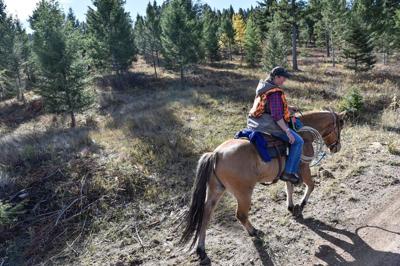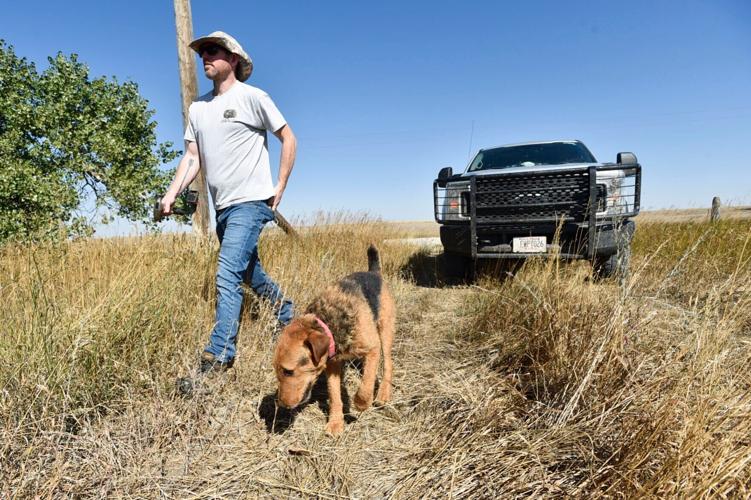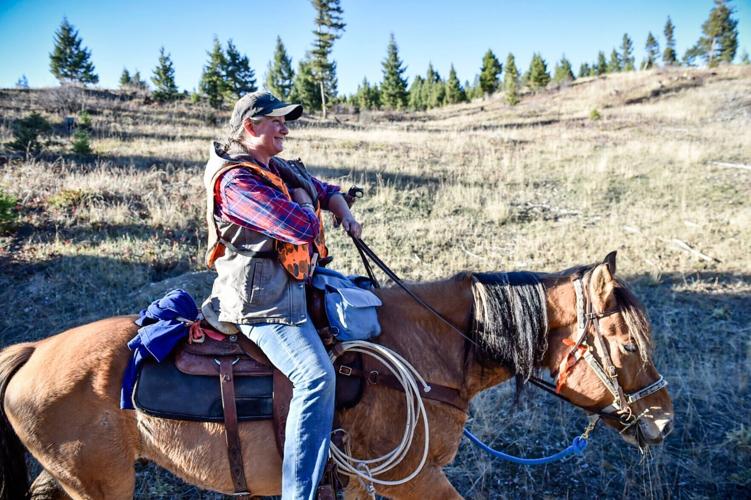Editor's note: This story is part of ',' a series that examines the past, present and future of the Endangered Species Act. Often called the "pit bull of environmental laws," the ESA has provided federal protection to nearlyĚý 2,000 animals and plants. On its 50th anniversary, it grapples with political uncertainty and unforeseen ecological challenges.
Some of the most efficient tools used today to keep predators away from livestock, grain and humans are the same ones that have been utilized for thousands of years – dogs andĚýshepherds.
“It’s kind of ironic, you know?” says Wesley Sarmento, Montana Fish, Wildlife & Park’s prairie bear specialist. “The recovery of these predators is requiring us to relearn ancient practices, we're having to re-learn how people lived with predators throughout all of human history.”
People are also reading…
Grizzly bears got federal protection soon after the Endangered Species Act was ratified in 1973. Fifty years later, the big bears are widely considered to be recovered in the Lower 48 states. Grizzlies remain listed under the ESA, although state and congressional leaders in Montana, Idaho and Wyoming have all demanded the bears be turned over to state management. Learning ways of co-existence may be key.
“Over the last 30 to 40 years of having those protections, grizzly bear populations have really rebounded, and they're increasing in both the numbers and now the distribution as well,” Sarmento said. “So that recovery zone is essentially full of bears. And so bears are expanding out from that mountainous environment onto the prairies, east of the Rocky Mountains.”
ł§˛ą»ĺ»ĺ±ô±đĚýłÜ±č
To Sigrid Olson, her job is simple. She’s the “eyes and ears” in the hills.
Her job as a range rider is to observe and monitor cattle and the predators who share the same landscape outside Potomac, in the Blackfoot River valley.
She is employed by the , whose mission is “to coordinate efforts to conserve and enhance natural resources and the rural way of life in the Blackfoot watershed for present and future generations.” Since 2008, the organization has worked with producers in the Blackfoot Valley to deploy range riders to monitor predators after the reintroduction of wolves. Range riding has become a powerful tool in preventing all predator conflicts.
Olson’s day starts with a drive south from Highway 200 down a bumpy road up the Ashby Creek drainage. In tow is a rumbling stock trailer with her horse Jake aboard.
The road ends at a gate where tens of thousands of acres of stateĚýand Bureau of Land ManagementĚýproperty feedĚývarious herds of cattle from producers in a local grazing association.
With a can of bear spray around her left arm and small digital camera tied to her right, she mounts her horse and rides out.
She isn’t looking for grizzly bears. She’s looking for cattle, using all of her senses to find signs of how predator and prey interact. The idea is simple: Put a human between the livestock and predators. This human presence becomes a deterrent for the hungry carnivores. It’s a practice used by humans for thousands of years.
As she rides, Olson leans over in the saddle scouring the ground for tracks and scat. She loves recent rain that makes tracks easy to spot. She uses her ears for the sound of scavenging birds overhead and her nose for the smell of carcasses and wildlife. She also deploys a network of game cameras so she has eyes all over, 24 hours a day.
Once Olson locates some cattle, she looks for injured or dead members of the herd. She also observes their behavior. Placid grazing, or agitated milling? The herd's anxiety level indicates the presence or absence of bovine threats. Anything she finds she jots down in a small notebook.
When the sun sets and the day’s ride is over, Olson takes everything she jotted down that day and shares a report of her findings to the ranchers and other interested parties. They in turn know to remove a carcass or treat an injured animal, reducing the attractants to grizzlies and other predators.Ěý
“Conflict prevention is a shared valueĚýamong all groups,” said Gary Burnett, who helped develop the range-rider program as leader of the Blackfoot Challenge before he became executive director of the Heart of the Rockies Initiative. “We all benefit from more conflict prevention programs. It’s as much a social program as it is a biological program.”
Another benefit according to Burnett is the ability to monitor loss. “If there is a compensation program, you have to confirm that loss. If you can’t confirm, you can’t claim that loss,” Burnett said.
The tools have proven so effective that in December, the U.S. Department of Agriculture for Montana and four other western states. About $16.5 million of that will flow through the Heart of the Rockies and Western Landowners Alliance.Ěý
“People working together and communicating helps me in the woods and it helps the producers feel good and then it helps the community as well.” Olson said. "It's something that I enjoy doing, and that I love doing. And I'm helping people at the same time.”
Let the dogs out
Early one morning last year, Jennie Becker sent her son Henry out to check on the flock of meat chickens on their ranch outside Conrad.
The scene Henry met was one of carnage. A grizzly bear got into the chicken coopĚýand wreaked havoc on the birds. Around 40 dead chickens lay on the lawn outside their house.
“That scared the daylights out of me,” Becker said. “That could have been his last day checking on the chickens."
From that day on, Stickleg Ranch operators Jennie and her husbandĚýSeth Becker embarked on a mission to coexist with grizzly bears. So they reached out to Wesley Sarmento, the prairie bear specialist for Montana Fish, Wildlife & Parks. He told them to get a dog.Ěý
But not just any dog. Specifically, Anatolian shepherd dogs.ĚýThe 100-plus-pound dirty white dogs came from nomadic tribes in the Middle East where they were bred to protect flocks of sheep from the same bears and wolves humans live with today.
Enter Zia and Astra, two young Anatolians bred for the job.
“We had reservations about it because we had a lot of misconceptions,” said Seth Becker. "We thought maybe they would be territorial. We thought maybe they'd be too aggressive with livestock or children."
But they discovered the dogs were quite the opposite. By day, the pair lay around from one shady spot to another on the ranch. But come night, they are on the prowl looking for hungry intruders in the coulees and grain fields nearby.
“From what we found they're great with children,"ĚýSarmento said. "They're great with people. They're great with other dogs. And so it's just been really awesome at keeping bears away from people."
“It literally changed our lives having these dogs,” Seth Becker added.
They no longer fear for the lives of their three children and countless livestock because there could be a bear napping in the brush or walking down the driveway at night. They've recorded aĚýsignificant drop in bear visitation to homes with the guardian dogs versus homes without.
For the Beckers, it’s their lives and livelihood on the line, but they wouldn’t want it with the bears gone all together.
“I think they're cool as heck. But I don't want them in my yard. And I don't want my kids to be threatened,” Seth Becker said. “Can it be Montana without the grizzlies?”ĚýĚý
Sarmento's position was createdĚýby the state’s wildlife agency in 2017 in response to the expanding grizzly bear population of the Northern Continental Divide Ecosystem, after increasing number of grizzlies were reportedĚýmaking their way from the mountains to the prairie. In mid-2023, confirmed sightings placed the big bears as far east as the Upper Missouri River Breaks north of Lewistown.
In addition to coordinating dogs and range riders, Sarmento's bear experts help prairie residents install electric fences to protect bee hives and calving and lambing yards.ĚýThey invested in a commercial size vacuum that can clean grain spills before the bears get on it.
“The overall goal is to keep people safe, and minimize the problems that bears cause and the concerns that bears cause,” Sarmento said. “When you do that, you increase tolerance for the species and people will be more willing to have bears around. And that's better for the species itself.”
What about the ranchers?
Denny Iverson has been raising cattle and working land shared by grizzlies since the 1970’s when his father moved the family out to the Blackfoot Valley from Minnesota. At the time, perhaps 600 grizzly bears remained alive south of the Canadian border. After a half-century of recovery efforts, an estimated 1,000 grizzlies inhabit the Northern Continental Divide Ecosystem, covering a swath of the Rocky Mountains between the Canadian border and Iverson's property.
The Endangered Species Act is credited with keeping almost 2,000 animals and plants from going extinct. But only about 3% of those have been taken off federal protectionĚý— a statistic many critics of the law consider a failure.Ěý
Grizzlies remain listed as a threatened species under the ESA, although state and congressional leaders in Montana, Idaho and Wyoming have all demanded the bears be turned over to state management.
Montana Republican Sen. Steve Daines recently warned U.S. Fish and Wildlife Service Director Martha Williams of the "weaponization of the ESA" by grizzly bear protection advocates who've sued to block wolf-trapping policies they say put grizzlies at risk.
“The litigation uses the Endangered Species Act and the current listed status of grizzly bears as a wedge to block the state from implementing science-based wolf trapping regulations," Daines wrote. "This ... alienates state and local partners who are best positioned to make positive gains for wildlife.”
FWS officials, in turn, have warned that the growing list of anti-predator laws and policies erode federal confidence that grizzly populations will be secure under state management. That could keep the bears under federal protection even longer as their numbers grow.
Today, Iverson is in the process of transitioning the operations of the Iverson Family Ranch to the next generation and he sees coexistence with predators as the only way forward. When asked if he likes grizzly bears, Iverson quickly responds “no” with the caveat that having them out there is pretty cool “as long as they are behaving themselves.”
“There’s more people in this countryĚýthat want grizzly bears on the landscape than don’t, and we have to come to the realization we have invaded [grizzly bears’] territory,” Iverson said. “So we've to work to live with them. We need to find the balance between using this land and having those same landscapes support grizzly bears.”
That balance is vital to the success of communities that rely on agriculture and public lands. Iverson acknowledges that agricultural operations are themselves attractions for predators but, on the same hand, says he has no plans of getting out of the business because of the predators.
“It's not just producer/predator coexistenceĚý—Ěýit's community-wide survival,” Iverson said.Ěý"There's areas in Montana where the whole community relies on the cattle producer having cattle on that public land. Without it, those cattle producers would be out of business. And then so would the town."



























